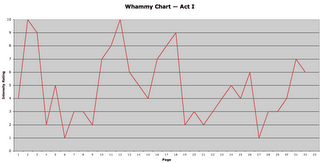Arousal's Whammy Chart
The first time Harvey Weinstein saw Clerks, he walked out: "It looks like hell and everyone's talking and nothing happens in the first five minutes."*
That painfully honest feedback was bouncing around in my head as I wrote Arousal's second draft. Weinstein wasn't wrong—generally, you know instantly whether you're going to like a movie or not. Not to say that rules can't be broken, but Clerks is the exception because Kevin Smith is endowned with a unique brand of whimsey.
Storytelling is, at its core, about sales. However, instead of selling a tangible product, you're selling an experience, a feeling. Because the key to sales is getting your foot in the door, you have to do or say something which grabs your potential customer's attention for the first 10 seconds. Once you've won that 10 second battle, you have to do or say something that buys you another 30 seconds, and then a minute, and then 10 minutes, then a half hour, then an hour. It's about small battles, carefully planned and executed.
For screenplays, this translates into pages: each page is a battle. Of course, each scene is a battle, too, but pages are a physical delimiter and if you can just... get them... to turn... that... page... YES! They'll read a little more... and then a little more. And look—a new scene! Why, what happens in that scene? Oh, I have to turn the page again? Okay... And so on. Pages are the small battles that win the war.
Thus, the Whammy Chart. It's so easy to focus on the particulars of a scene, to weed out the plot implausibilities, correct the typos, the vapid dialogue, the stale characterization... and all the while, lose sight of how the script feels as a whole. This technique is mentioned in Writing Treatments that Sell, among other places. It measures the story's intensity rating on a page by page basis and provides a holistic viewpoint where a script's weak points (and strong points) stand out immediately.  Using Excel, this is the Whammy Chart I completed for Arousal's Act I. I had been concerned not enough conflict was happening to get readers to turn the page, and I was right. This is the amended Whammy chart, so you can't really see what the original story looked like, but the first draft had a lot of 2's and 3's in the first 15 pages. I pictured myself sitting in the audience with Harvey Weinstein as he assailed the screen, "Nothing happens in the first five minutes!!! Killing... me..."
Using Excel, this is the Whammy Chart I completed for Arousal's Act I. I had been concerned not enough conflict was happening to get readers to turn the page, and I was right. This is the amended Whammy chart, so you can't really see what the original story looked like, but the first draft had a lot of 2's and 3's in the first 15 pages. I pictured myself sitting in the audience with Harvey Weinstein as he assailed the screen, "Nothing happens in the first five minutes!!! Killing... me..."
Thanks to my Whammy Chart, I revamped Arousal to make the threat more real in the first 3 pages. In theory, the palpable danger should give the reader enough whiplash to want to read until the 10 page mark, where something else side-swipes them. That should kick them to the end of page 30... and so on. Evidently, readers agreed.
On a micro scale, the Whammy Chart is also useful as a mental guide: whenever I'm done with a draft, I weigh the pace and tension happening across each page, and—starting with page 1—try to move the paragraphs around so that the bottom of each page ends with a mini-cliffhanger. I am, literally, trying to create a page-turner. No novelist can ever pull that trick out of his tool chest!
* Harvey was told to watch Clerks again and "keep thinking 37". Miramax eventually bought Clerks for $227,000.


2 comments:
"keep thinking 37"???
I can't spoil it for anyone who hasn't seen it, but if you have seen Clerks and don't remember, click here, do a text search for "three different" and read that section.
Post a Comment